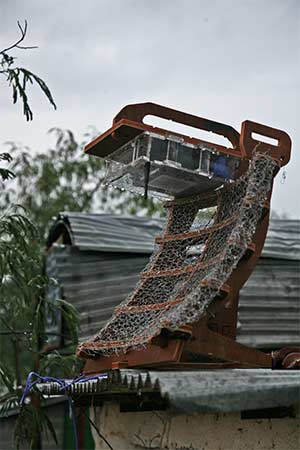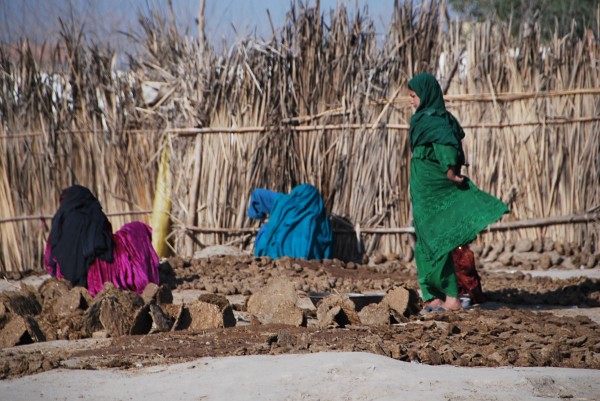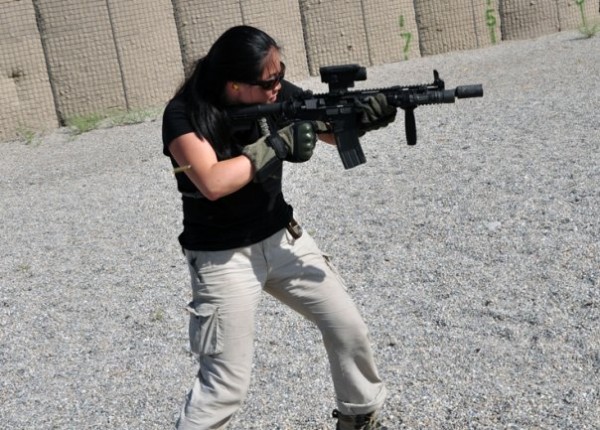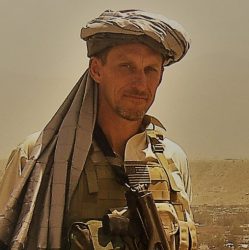Editors Note: In this post Keith Berkoben and Amy Sun from the Center for Bits and Atoms at MIT report on the Fab Fi network in Jalalabad. These are cross posted on the Jalalabad Fab Lab blog. Keith is first up with great news on the continued growth of the fab fi mesh around Jalalabad City. Twenty five nodes up and running simultaneously – pretty impressive. Amy Sun follows with a solid demonstration of using keen insight, humor and classic leadership skills while working through language and cultural difficulties to do a little problem solving.
KEITH BERKOBEN
When we first brought FabFi to Afghanistan we brought our own idea of the best solution. It looked something like the photo below. With a little training, our afghan friends figured out how to copy reflectors like the one in the photo and make links. That’s super cool and all, but you can’t always get nice plywood and wire mesh and acrylic and Shop Bot time when you want to make a link. Maybe it’s the middle of the night and the lab is closed. Maybe you spent all your money on a router and all you have left for a reflector is the junk in your back yard. That, dear world, is when you IMPROVISE:

Pictured below is a makeshift reflector constructed from pieces of board, wire, a plastic tub and, ironically enough, a couple of USAID vegetable oil cans that was made today by Hameed, Rahmat and their friend “Mr. Willy”. It is TOTALLY AWESOME, and EXACTLY what Fab is all about.

For those of you who are suckers for numbers, the reflector links up just shy of -71dBm at about 1km, giving it a gain of somewhere between 5 and 6dBi. With a little tweaking and a true parabolic shape, it could easily be as powerful as the small FabFi pictured above (which is roughly 8-10dBi depending on materials)

For me, the irony of the graphic above is particularly acute when one considers that an 18-month World Bank funded infrastructure project to bring internet connectivity to Afghanistan began more than SEVEN YEARS ago and only made its first international link this June. That project, despite hundreds of millions of dollars in funding, is still far from being complete while FabLabbers are building useful infrastructure for pennies on the dollar out of their garbage.

AMY SUN
I haven’t been in Afghanistan since September, missing my January window of opportunity this year. Fortunately, our Afghans have discovered Skype and the FabFi-GATR-internet has been sufficiently stable that I haven’t missed much.
Having Afghans with high speed internet and skype is pretty much like having TV (something else we don’t have by choice, like heat). The intrepid FabFi team in Afghanistan (now exclusively Afghans) have been expanding at a quick pace and everyone wants to gab. As long as the connection is up it seems at least one is online and wants to chat. Some of it is utterly content-less and we patiently plod through with the idea that it’s good English practice. Keith is fantastic at half-rolling out of bed in the morning for a couple hours of conversing – I’m just not socially presentable until there’s at least a couple cups of coffee in me.

Previously on That Afghan Show,
One night around 2300 Afghan time, our friends Hameed and Rahmat wanted to video skype with us but the city power isn’t on then. So in the darkness they went to the hospital water tower and climbed the 5 stories to the tippy top and chatted with us from the windy roof of Jalalabad in the middle of the night. We couldn’t see them so well since they were only lit by the light of their own laptop but they could see and hear us which made them silly happy. I hope that gives readers a decent impression of the security situation – it’s not a war zone everywhere. In some places, it’s like any other city with people that just wanna reach out and chat with their friends.
Logistically the FabFi mesh network is hampered by difficulties in obtaining routers in country. This is completely my fault though I thought that I had verified that you could get these routers on my first trip. But progress is occurring even though sometimes it’s hard to see. We’ve discovered that the Afghan fab folk can get joint personal bank accounts at the Jbad branch of Kabul Bank which is backed by some German bank. We’re able to wire transfer funds to and from each other. Now, Afghans can wire us money to purchase routers which we ship to them. In theory, anyway, next week we’re going to try to transfer a small sum to see how it goes. It’s a sore point in our project because it takes local shopkeepers out of the loop and creates a large reliance on order it from America.

The drama these days is a brewing conflict over the key to the water tower at the public health hospital (PHH). Edited to fit your screen and time limits:
HAMEED: Problem: Someone broke the old lock and installed another lock. We (Rahmat and Hameed) have no key to the water tower now. We are about to start working on another connection and may need to get to the tower. Please tell Talwar or someone at the Fablab to give us a key to it. I can get to the top of the tower from another way without opening the lock. But it’d be handy for Rahmat.
RAHMAT: yes that is what we want. there are many people asking us for net connection. but we say them that you need routers and they just find it hard to find routers in Afghanistan or Pakistan
TALWAR (to Amy): Dear Amy sun I did not broken the lock Mr Dr. Shakoor change the lock he toled me Mr Talwar every one in every time going up to the tower we dont know these poeple if some one do something wrong in the tower are you resposible of that i toled him no i am resposible of myself therefor he changed the lock
AMY: I am not your mother (all of you), do not come crying to me when you can’t get along. Afghanistan has many difficulties in her future and you must become brothers and work together to build a working city and country you are proud of. This starts with communicating with each other especially for something so simple as a shared key to a shared resource. I can think of many possible solutions to the who has a key problem, can you? Talwar, Hameed, Rahmat – you are all intelligent grown men capable of figuring out what is the right thing to do. Do it.
TALWAR: Thanks Miss Amy sun form your direction that you gave to Mr Rahmat and Hameed your right your not our mother to solve our all problem we should tray to solve our problem by ourslefe and work friendly. bu i dont know why mr Hameed asked you for the Key he didnot asked me yet for the key, he did not asked in the hospital for the key. is the key is with you they are asking you for the key?
M: Just talked with Talwar and he told me he would leave the key with Dr. Shakoor, head doc, at hospital.
HAMEED: Regarding Talwar, we’ll try to work something out with him.
RAHMAT (to Amy): Yes you said very good things and I agree with.
RAHMAT (to Keith): but we have a small problem that is the key of water tower to which we have no access. the one we have put here has been broken by someone
KEITH: I understand that Talwar has a key. Has Hameed gone to ask him for it?
RAHMAT: Not yet nowadays Hameed is busy with his exams and we will going to activate another new connection these days. We are not fighting we just want the fablab to be extended in Jalalabad
KEITH: Talwar is probably worried that he is losing control of something by giving you access. You must make him see how all of you will be better off by working together.
B: I called Dr. S. He is not budging on having a gate on the tower. He says the key is with him and not with Talwar. I told him that he has to make sure that Hameed can have access to this key when ever he needs it. If there is ever a problem he should call Dr. S. If that doesnt work, he should call me and I will call Dr. S. This is far from an optimal solution, but as Dr. S is unwilling to make copies of keys this seems to be the only option.
I explicitly told Dr.S that Talwar cannot be part of the key handout process. He agreed to this and said that anytime H or R call him he will give it to them directly.
RAHMAT: I , Hameed and one of fabfi users went to Dr.S directly and asked him to give us the key he told us that there are many security reasons that they don’t want to give the key to everyone and also told us that only Talwar will fix everything and also he was telling us that instead of internet the water tower and its water is very important.
TALWAR: i am not the director of hospital to be responsible of the hole hospital that every one coming to me and say give me the key of water tower. dear, hospital has there own director the key is with him every one can get from him not from me than why every make me blame.
We’re now entering the third week of this plot arc. It’s funny, but it’s not. This set of guys are our friends and some of the best hope we’ve seen. They’re intelligent, dedicated, trustworthy, and diligent. They know each other and have worked together to make and assemble reflectors and grow the project, and yet they’re stumbling here where there needs compromise and communication. <sigh> But of course, when and how would they have had opportunity to see this behavior in action?
Baba Tim: Anyone who has spent time working with Afghans has a story similar to Amy’s tale above. The take away point to these two posts is that there is nothing hard about doing COIN. You just have to get out and do it…..it is that easy. Once again I feel compelled to point out that all the good work being done by the Fab Folk is self funded. They have reached the end of their resources and could use a little help. Please take the time to stop by Amy Sun’s blog to donate what you can in support of the Jalalabad Fab Lab. The smoking fast internet we have all enjoyed for the past two years is about to go away forcing Team MIT to come up with a replacement. Without some sort of funding their two years of work will go down the memory hole taking all the hope, dreams, and potential of the local children with it.



Wow, you guys rock! Keith thanks for taking the time to post.
I keep reading this blog and when I read other blogs about the region I wonder, does anyone know WTF is going on? Tim’s posts about local engagement are amazing, true warriors you all are. True story!
tnx for the update on the Lab! Good news, we need them )
Outstanding – Fabfolk rule..
Someone, Somewhere has got to eventually GET IT..
this is what is supposed to be done, and being done on pennies.. makes it even more awesome. .
Great Works !
Great to see an update, ive just arrived in Qalat and have been thinking this concept might work here
This might be helpful. http://www.usbwifi.orconhosting.net.nz/
Thanks for the tip Scott. In the small world department when you were graduating from the Academy my father was a company officer there and I was attending West Annapolis Elementary School. Annapolis today is just not the same as I remember it back in the 60’s. But I love that town all the same.
Thanks for taking the time to comment on FRI.
Maybe even smaller. My company officer (20th Co.) was a Marine. Your site is outstanding. My goto along with Mike Yon’s. Glad to contribute.
My bad. You Dad was 28th Co. I push your site to my military friends. Keep up the good work and quest for better thinking amongst the PTB>
Tim,
This is good stuff and the kind of COIN initiatives we should be hearing and reading about in the MSM. Sadly, the military and Department of State are too mired in bueracracy and politics to make an initiative like this one a success. They would outsource on a contract bid and from there it becomes about the bottom line of profit versus costs and not so much about helping the people of Afghanistan.
Thanks for reminding us it doesn’t take millions and millions of dollars to improve the lives of the Afghan people.
The challenge is not running cheap mesh/MANs around Jalalabad using repurposed WRT54GLs and pringles cans. As the Fabfi people have proven that can be done with a very low budget and a lot of improvisation. Afghanistan’s satellite, microwave relay and fiber optic connections to the outside world are the bottleneck.
“Afghanistan’s satellite, microwave relay and fiber optic connections to the outside world are the bottleneck.”
True dat, Fiber,.. we wish.. !!! Its laid in some local areas, but not connected to shit… but with some creativity, and entrepreneurlism.. we are cracking that nut. Come a LONG way in last 3 years… There was ONE internet cafe in 2006.. now there are dozens in jbad.
Okay, so that was easy. I just ordered the facial emotion cards via Amazon and they’ll be sent directly to Amy. Really, the things on her list are very inexpensive. Just choose one –and the collection will grow.
Just for sauce.
Bluetooth and other wireless devices were used to hone in on targets when insurgents were lopping mortars in.
I’d be GLAD to go over there and setup wireless….. *sarcasm*
Doing COIN is about being transparent and communicating directly. On something like having access to the key to a water tower or anything shared in common, communicating face-to-face is usually the best solution. If I were in that situation I would suggest that the 3 or 4 people directly involved need to meet in person and talk TO each other. Online they are just talking AT each other, and not solving anything.
Yo –
Got an APO or other semi-reliable address? I’d love to ship out some old 802.11b & b/g gear. Much better use than simple local recycling?
Amy I need your help!!
Wanted similar thing in a remote village in Nigeria. Can you help?
Dear everyone – first of all, Thank You! It’s so great to hear comments that aren’t coming from inside my own head.
Once again I’m shaking my head in amazement at how many people in the world read Baba Tim’s little blog. We were Boingboing’ed then gizmodo’ed then /.’ed, and that exploded into far too many requests for information which among other things took down our server. All while I was in Haiti and “connected” via the absolute opposite of “high speed internet”.
I have a ton of updates since this post and of course we’re behind in keeping our blog and websites updated. You’ll see some of this stuff show up in more detail at the FabFi Blog over the next few weeks.
Here are the highlights:
In Haiti I found an amazing group with who we’ll be doing nationwide wireless a la FabFi. In addition to building the infrastructure, there is a very strong focus on services that will be available within the network alongside GSM bridging. Some of the comments deal with the bottleneck of reaching the “Big Internet” and the island nature of Haiti sharpens that problem. In addition to mirroring the common and popular content in country and implementing proxy servers to use the outgoing bandwidth more efficiently, the Haitians are explicitly interested in locally generated content and intra-net communications.
This is the awesome part of the way we work, the Haitians get to benefit directly from the output of what the Afghans have learned in making their network, which will allow the Haitians to skip the early fiddling and development and get right to the services and content. Reciprocally, the services and content they figure out will installable in Jbad without the Afghans poking at the software. Better yet, they’ll work on things together, along with the Peruvians, Ethiopians, Indians, Spaniards, and other fab labbers who have begun to make networks too.
I think I’ve mentioned before – we don’t really know what we’re doing and just learn stuff along the way. That turns out to be a feature because the Afghans watch us figure stuff out and in turn learn how to learn, how to ask, how to experiment. That said, we need help.
If you have experience, hardware, donations, time, contacts, resources, or words of encouragement please email me. We’ve moved beyond needing simply RF, networking, antennas, etc. and now need all kinds of tech (mechanical, chem (esp. polymers), electrical (esp. FM xmit/rcvr, microcontrollers, and power conditioning)), GIS/mapping/pointing, every kind of software and web, language (esp. translations) as well as technical project management and social science analysis writer types. If all goes well, soon we’ll need some regular old back office help too.
ps –
PDT guy: I can’t find your email. Next stop in Afghanistan is your current AO. I think we absolutely need your help!
Ezuks – the email address you posted is invalid. Write again.
Hillery – need exact model numbers and/or you can ship to Boston (where I’m based) for evaluation/hacking.
anyone in Boston – the FabFi in Jbad *might* be in today’s Herald (Sunday 3/28). I wasn’t paying attention to which Sunday. If you see us, let us know!
You guys are doing a fab job. Read the article in the sunday Herald 4/11.